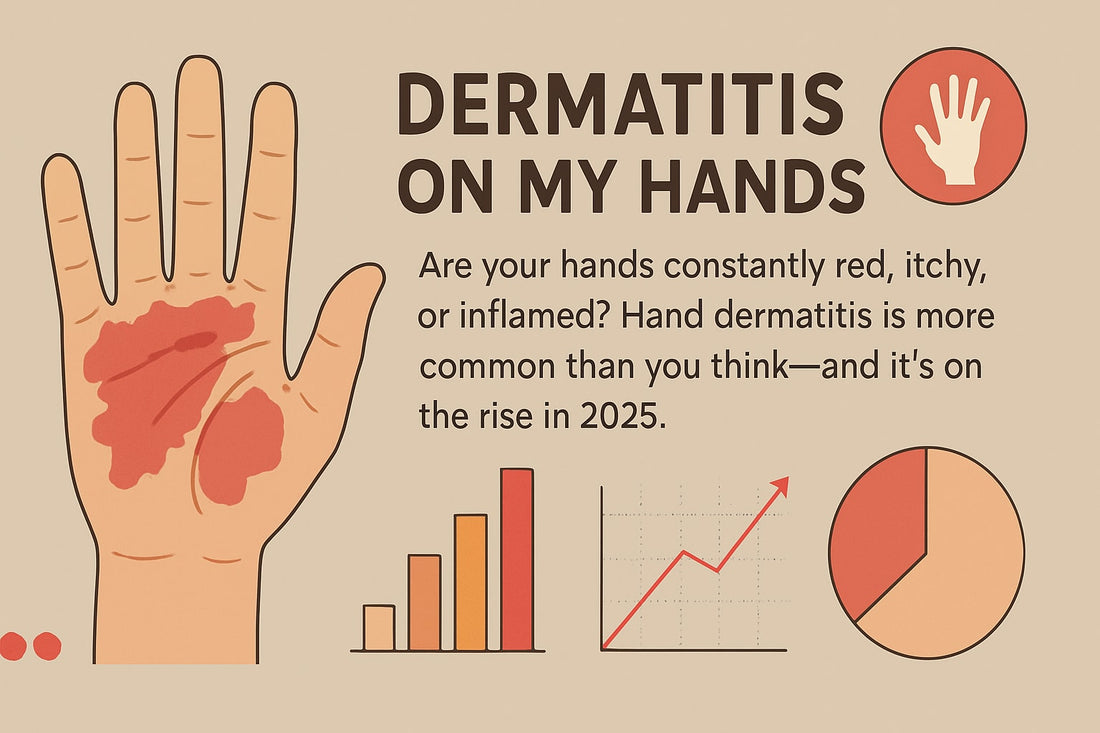
Dermatitis On My Hands: The Essential Guide 2025
Are your hands constantly red, itchy, or inflamed? If you’ve ever thought, “Why is dermatitis on my hands getting worse?” you’re not alone. In 2025, more New Zealanders than ever are dealing with this challenging skin condition.
Hand dermatitis can disrupt work, family life, and even simple daily tasks. Increased hygiene habits and changing environments have led to a noticeable rise in cases across NZ.
Finding relief means more than just covering up symptoms. You deserve solutions that are effective, natural, and grounded in science. This essential guide will walk you through the causes, symptoms, diagnosis, and the very latest in treatment options—including cutting-edge natural therapies from New Zealand. You’ll also discover prevention strategies and expert tips for managing dermatitis on your hands, so you can get back to living comfortably.
Understanding Hand Dermatitis: Causes and Risk Factors
Hand dermatitis is a skin condition that affects thousands across New Zealand, often leaving people wondering, "Why do I have dermatitis on my hands?" Let’s break down what makes this condition unique, who’s most at risk, and why it’s such a challenge for so many Kiwis.
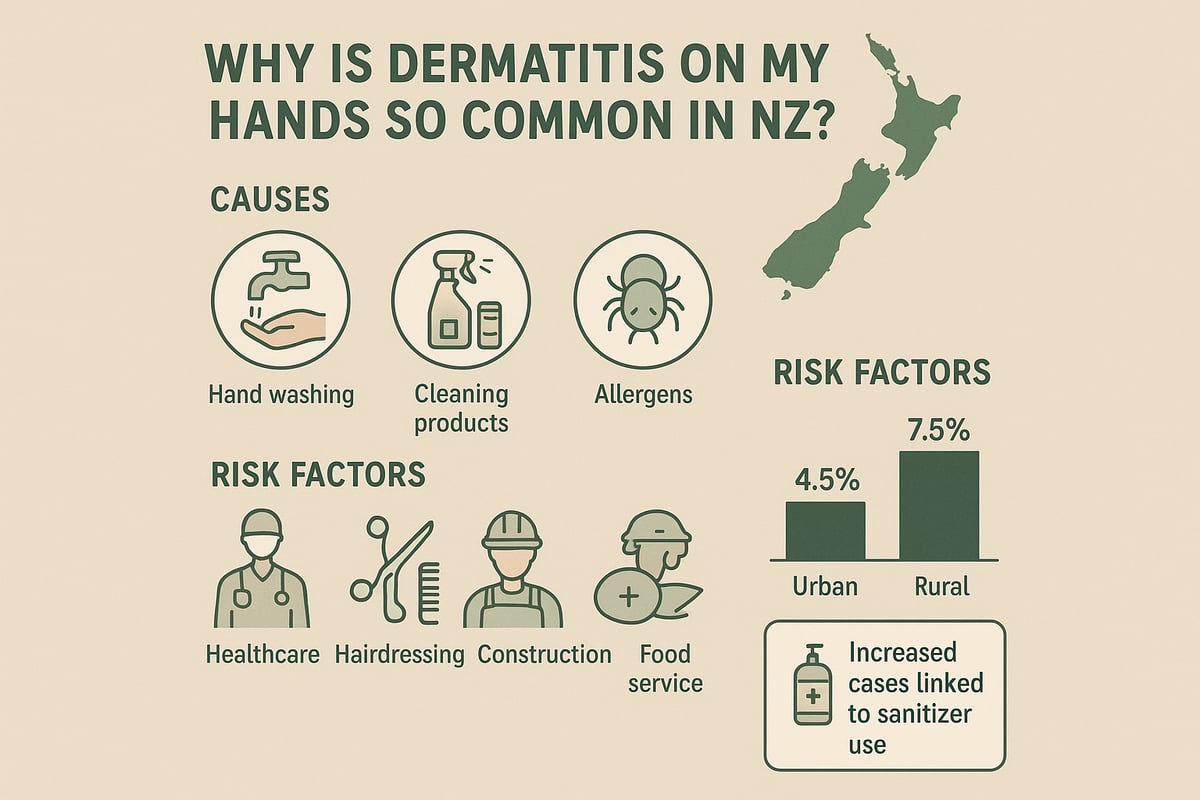
What Is Hand Dermatitis?
Hand dermatitis on my hands is a type of eczema that causes redness, itching, and irritation. Unlike other skin conditions, it specifically targets the hands and can take several forms, such as atopic dermatitis, contact dermatitis (allergic and irritant), or dyshidrotic eczema.
Each type has unique triggers and symptoms, making it important to distinguish them from other rashes like psoriasis or fungal infections. Understanding exactly what dermatitis on my hands is will help you take the right steps towards relief.
Common Causes and Triggers
Ever wondered why dermatitis on my hands seems to flare up at the worst times? Common culprits include:
- Frequent hand washing with harsh soaps
- Exposure to cleaning agents at home or work
- Common allergens like nickel, latex, fragrances, and preservatives
- Seasonal changes, especially the chilly, dry winters in New Zealand
Certain jobs, such as healthcare, hairdressing, construction, and food service, carry higher risks. In fact, a Hand dermatitis in New Zealand cleaners study found professional cleaners had significantly higher rates of dermatitis on my hands due to repeated exposure to irritants.
Winter months often see a spike in cases, with many Kiwis reporting cracked, painful skin. Identifying your personal triggers is the first step to breaking the cycle.
Who’s Most at Risk?
Up to 10% of New Zealand adults report struggling with dermatitis on my hands. People with a family history of eczema, hay fever, or asthma are more likely to be affected.
Women are statistically more prone, often due to both genetic and occupational factors. Genetics and underlying atopic conditions make some individuals especially sensitive, while constant exposure in certain jobs increases the risk for others.
Environmental and Lifestyle Factors
Urban living, pollution, and ongoing post-pandemic hygiene practices are changing the landscape for hand health. A 2024 NZ study linked increased use of hand sanitisers to a rise in dermatitis on my hands, especially in city environments.
Higher pollution levels and exposure to new chemicals in urban areas act as additional stressors. The combination of lifestyle and environment means more New Zealanders than ever are dealing with flare-ups, even those with no prior history.
The Role of Skin Barrier Dysfunction
At the heart of dermatitis on my hands is a weakened skin barrier. When this natural shield is damaged, irritants and allergens can sneak in, causing inflammation and discomfort.
A real-world example: a New Zealand nurse developed severe dermatitis on my hands after months of wearing latex gloves and using hospital-grade sanitisers. Her skin’s barrier broke down, leading to painful cracks and persistent itching.
Understanding this process is key. By strengthening the skin barrier and avoiding triggers, you can reclaim comfort and confidence in your daily life.
Recognising Symptoms and Getting Diagnosed
Do you often wonder if the redness, itchiness, or dryness you feel is simply dry skin or something more? Recognising the signs of dermatitis on my hands is the first step toward finding real relief. Let’s explore what to look for, when to seek help, and how diagnosis works, so you can take charge of your skin health.
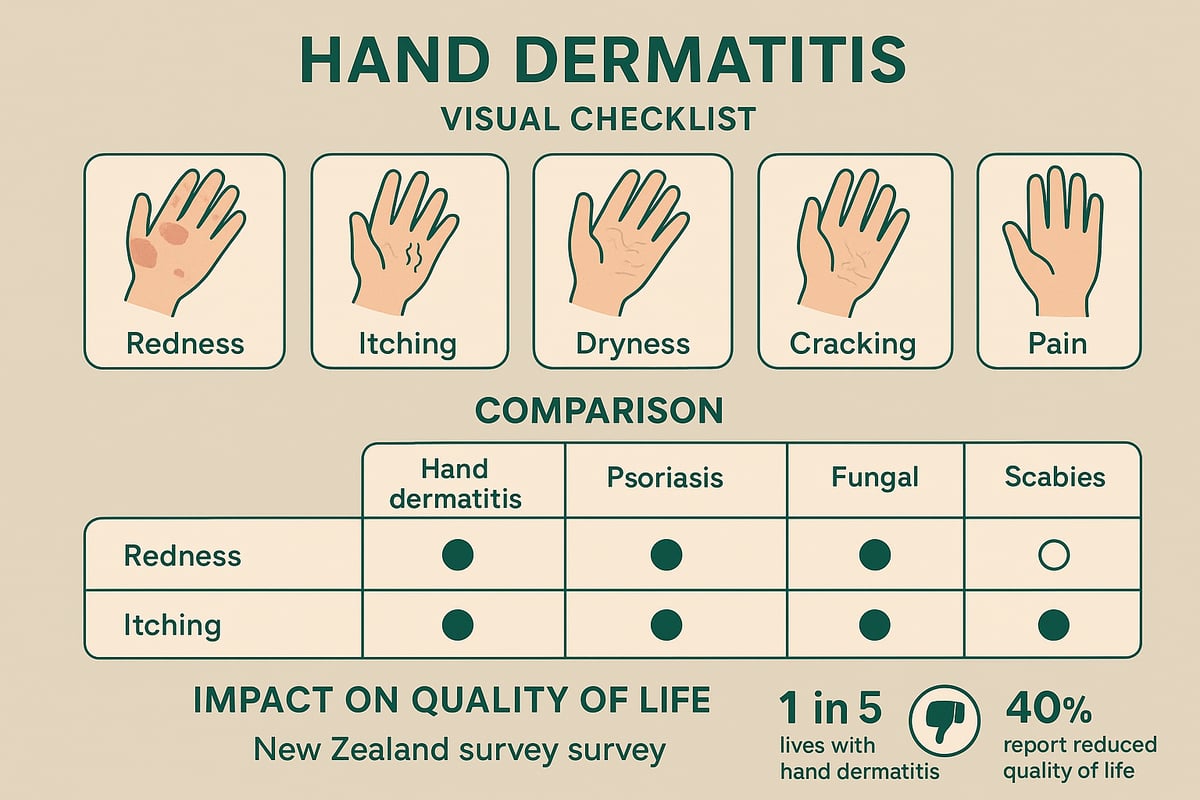
Key Symptoms of Hand Dermatitis
Dermatitis on my hands often starts with redness and itching. You might notice your skin feels dry or rough, and it can quickly progress to cracking, flaking, or even painful blisters. Some people experience swelling and a burning sensation, especially after coming into contact with irritants or allergens.
Symptoms can be either acute (sudden and severe) or chronic (persistent and recurring). Acute flares may involve intense itching and weeping blisters, while chronic cases often show thickened, cracked skin that worsens in winter. For instance, many New Zealanders report cracked knuckles and rough patches after months of colder weather.
It’s important to keep track of when and how these symptoms appear, as it can help you and your healthcare provider pinpoint triggers.
When to Seek Medical Advice
If dermatitis on my hands persists for more than a few weeks, spreads, or worsens, it’s time to consult a doctor. Watch for signs of infection, such as oozing, pus, or fever, which may require urgent care.
Seek medical advice if over-the-counter treatments aren't helping, or if the condition interferes with daily activities. Early intervention can prevent complications and improve quality of life.
Diagnostic Process
Diagnosing dermatitis on my hands starts with a thorough clinical examination. Your doctor will ask about your symptoms, lifestyle, and any known allergies or irritant exposures. Patch testing may be used to identify specific allergens, especially if allergic contact dermatitis is suspected.
New Zealand dermatologists follow evidence-based guidelines, ensuring accurate diagnosis and tailored treatment. Sometimes, further tests are needed to rule out infections or other skin conditions. Keeping a symptom diary can be helpful during this process.
Differentiating from Other Hand Rashes
Not every rash is dermatitis on my hands. Other conditions, like psoriasis, fungal infections, or scabies, can look similar but require different treatments. Psoriasis often appears as silvery, scaly plaques, while fungal infections may cause ring-shaped red patches. Scabies, on the other hand, typically involves intense itching and small burrows.
A visual comparison and professional assessment help avoid common misdiagnoses. For a deeper dive into how to tell these conditions apart, check out Dermatitis and Dandruff Insights.
Impact on Daily Life and Mental Health
Living with dermatitis on my hands can be both physically and emotionally draining. Everyday tasks like typing, cleaning, or even shaking hands can become painful or embarrassing.
A recent New Zealand survey found that 40% of people with hand eczema report a reduced quality of life. This ongoing discomfort can lead to frustration, stress, and even social withdrawal. Recognising the impact is key to seeking support and finding solutions that restore confidence and comfort.
Latest Treatments for Hand Dermatitis in 2025
Finding the right approach to treat dermatitis on my hands can be life-changing. As new therapies and natural solutions emerge, let’s explore the latest science-backed options available in New Zealand for 2025.
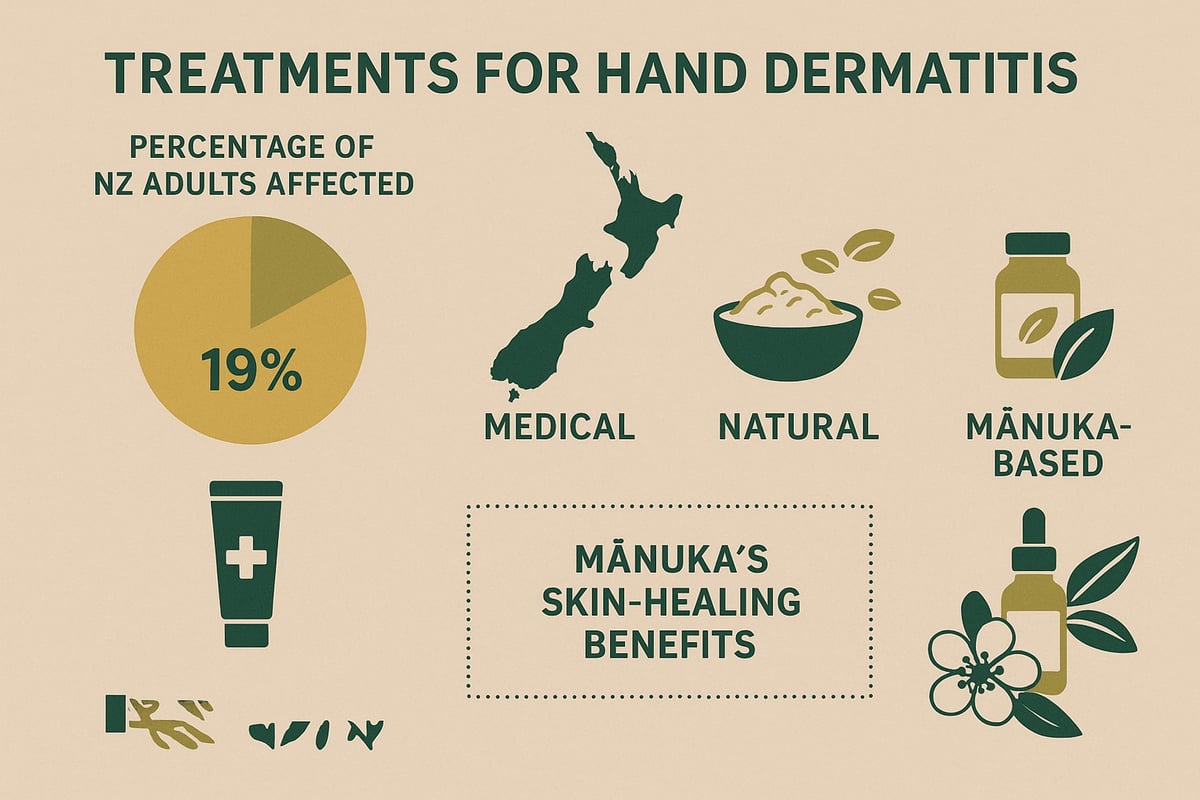
Medical Treatments and Prescriptions
Doctors in New Zealand often start with topical corticosteroids to manage inflammation and itching. These creams come in different strengths, so your GP will recommend one suited to the severity of dermatitis on my hands. For stubborn cases, calcineurin inhibitors or oral medications may be prescribed.
Phototherapy is another option, especially for chronic hand eczema that does not improve with creams. This treatment uses controlled UV light and is available in select NZ dermatology clinics. While these therapies can bring relief, it is vital to use them as directed, as overuse of steroids can thin the skin over time.
Advances in Natural and Alternative Therapies
Many Kiwis seek steroid-free options for dermatitis on my hands. Oatmeal baths and coconut oil are popular, backed by research for their soothing and barrier-repairing effects. Recent NZ studies highlight the benefits of natural remedies in reducing flare-ups and supporting skin health.
A 2024 clinical review found that botanical solutions, including aloe vera and calendula, can help calm irritation and restore moisture. These alternatives are especially valued for long-term management, as they are gentle enough for repeated use. People with sensitive skin or recurring symptoms often find these natural options provide comfort without harsh side effects.
The Role of Full Spectrum Mānuka Extracts from New Zealand
Full Spectrum Mānuka Extract is gaining attention for its powerful anti-inflammatory and antibacterial properties. Unlike standard Mānuka oil, this world-first extract from Waipu Extracts retains all the beneficial compounds found in the plant, maximising its effectiveness for dermatitis on my hands.
Scientific studies show that Mānuka supports skin barrier repair, helping to lock in moisture and defend against irritants. NZ customers report rapid relief, reduced redness, and visible healing, especially when other treatments have failed. For a deeper dive into the science behind Mānuka’s skin-healing power, see Manuka's Skin Healing Benefits.
Compared to synthetic treatments, Full Spectrum Mānuka Extract offers a sustainable, pure solution unique to New Zealand’s environment. Its traceability and eco-friendly harvesting make it a trusted choice for those seeking natural relief.
Choosing the Right Treatment Plan
Every case of dermatitis on my hands is different. The best results come from a personalised plan that considers your symptoms, triggers, and preferences. Some people combine prescription creams with natural therapies like Mānuka extract for a balanced approach.
It is important to keep track of how your skin responds to each treatment. Regular check-ins with your GP or dermatologist ensure your plan stays effective and safe over time. Discuss any side effects or concerns early, so adjustments can be made if needed.
Managing Flare-Ups and Preventing Recurrence
Early action makes a big difference when managing flare-ups of dermatitis on my hands. As soon as you notice redness or itching, gently cleanse and moisturise your hands, then apply your prescribed or natural remedy. Use gloves for household chores and avoid known irritants to protect healing skin.
Ongoing care means sticking to your skincare routine, even when symptoms improve. Keep a symptom diary, review your triggers, and update your treatment plan as your needs change. These simple steps help keep your hands healthy and reduce the risk of future flare-ups.

Step-by-Step Guide: Managing Hand Dermatitis at Home
Struggling with dermatitis on my hands can feel overwhelming, but a clear, step-by-step routine makes it manageable. With the right approach, you can protect your skin, reduce flare-ups, and regain comfort in daily life. Let’s walk through each essential step for effective at-home care.
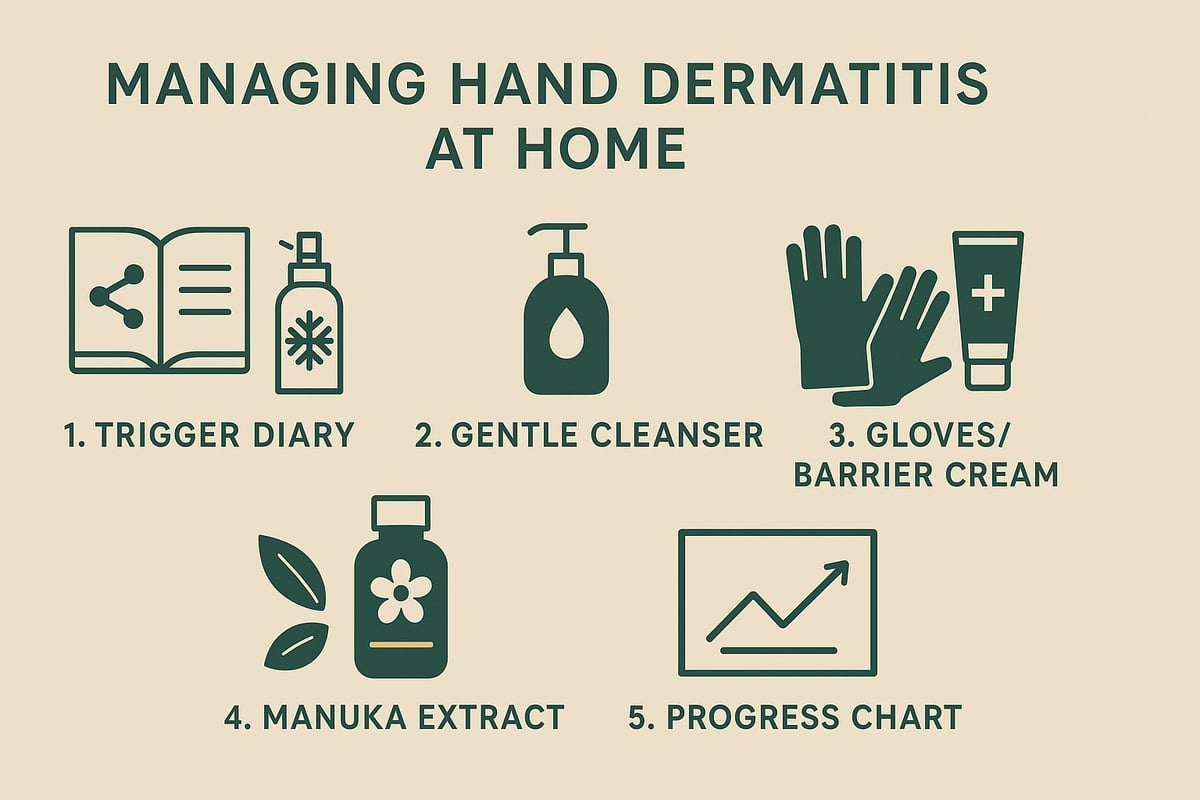
Step 1: Identify and Avoid Triggers
The first step in managing dermatitis on my hands is knowing what sets it off. Start a simple symptom diary, jotting down when flare-ups occur and what you were doing.
Common triggers include:
- Cleaning products and soaps found in many NZ households
- Repeated hand washing or sanitiser use at work
- Allergens like nickel, latex, and strong fragrances
By spotting patterns, you can avoid or replace harsh products, making it easier to keep symptoms under control.
Step 2: Gentle Cleansing and Moisturising
Caring for dermatitis on my hands means choosing products that nurture, not irritate. Always wash with a fragrance-free, pH-balanced cleanser. Avoid hot water, which can further dry out your skin.
Best practices:
- Moisturise immediately after washing and before bed
- Choose thick, non-greasy creams or ointments
- In NZ winters, increase moisturiser use to combat dryness
A consistent routine helps strengthen your skin barrier, keeping hands soft and reducing flare-ups.
Step 3: Protective Measures
Protection is key when living with dermatitis on my hands. Use gloves for cleaning, gardening, or food prep, and opt for cotton liners under rubber gloves if you’re sensitive.
Tips for extra protection:
- Apply barrier creams/balms before tasks involving water or chemicals
- Use gloves suited to your job, especially in healthcare or food service
- Let hands air dry before putting on gloves
Consistent protection helps prevent new irritations and supports healing.
Step 4: Incorporating Natural Solutions
Many New Zealanders are turning to natural therapies for dermatitis on my hands. Full Spectrum Mānuka Extract, sourced locally, is renowned for its calming, antibacterial, and barrier-repairing qualities. Apply a few drops to affected areas twice daily, letting it absorb fully. For extra support in-between application, apply Waipu Extracts' skin rescue balm.
For more options, combine with:
- Oatmeal soaks for itch relief
- Aloe vera gel to soothe redness
- See more ideas in Clearing Eczema Naturally
Choose NZ-made products with pure, sustainable ingredients for the best results.
Step 5: Monitoring Progress and When to Seek Help
Track changes in your skin by noting daily symptoms and what treatments you use. If dermatitis on my hands worsens, spreads, or shows signs of infection (like oozing or pus), it’s time to consult a GP or dermatologist.
Stay proactive:
- Review your routine every few weeks
- Adjust products if irritation persists
- Don’t hesitate to seek expert advice for stubborn cases
With patience, you can find lasting relief and regain confidence in your hands.
Prevention Strategies for Healthy Hands
Keeping your hands healthy can feel like a challenge, especially if you’re struggling with dermatitis on my hands. The good news? Simple daily habits and smart prevention can make a real difference. Let’s break down the essentials for stronger, happier skin.
Daily Habits to Protect Your Skin
Everyday routines can help prevent flare-ups of dermatitis on my hands. Always use lukewarm water and fragrance-free, gentle cleansers when washing your hands. Pat hands dry rather than rubbing, and apply moisturiser immediately after.
Wearing gloves for chores like cleaning, gardening, or washing dishes adds a protective barrier. Cotton gloves under rubber ones work well for sensitive skin. Consistency is key—make moisturising part of your morning and night routine.
| Habit | Why It Matters | How Often |
|---|---|---|
| Gentle washing | Avoids stripping natural oils | Every wash |
| Moisturising | Repairs and protects skin barrier | After washing, before bed |
| Gloves | Shields from irritants and water | During chores |
Building a Resilient Skin Barrier
A strong skin barrier is your best defence against dermatitis on my hands. Hydrate from the inside out by drinking plenty of water throughout the day. Choose a balanced diet rich in omega-3s (think salmon, walnuts), vitamin D, and zinc to support skin healing.
Moisturisers containing natural ingredients like Full Spectrum Mānuka Extract can help repair and strengthen the skin’s outer layer. This science-backed New Zealand extract offers anti-inflammatory and antibacterial benefits, supporting your defence against future flare-ups.
Workplace and Environmental Adjustments
If you’re at risk of dermatitis on my hands due to your job, talk with your employer about reducing contact with known irritants. In New Zealand, workplace safety guidelines encourage providing appropriate gloves, barrier creams, and regular breaks for hand care.
Simple changes like better ventilation, switching to milder cleaning products, or using hand sanitiser alternatives can also help. Employers should offer training on skin protection and ensure easy access to hand care products.
Early Intervention and Ongoing Care
Spotting early warning signs is vital. Redness, itching, or dryness can signal a flare-up, so act quickly with moisturiser and avoid triggers. Ongoing care routines are essential for long-term prevention.
Many New Zealanders find that combining medical advice with natural solutions, like those highlighted in the Eczema Trial Week One Results, leads to better outcomes. Staying proactive helps prevent dermatitis on my hands from becoming a chronic problem.
Expert Tips, Myths, and FAQs About Hand Dermatitis
Living with dermatitis on my hands can feel overwhelming, but expert advice and the right information make a world of difference. Here, we break down the latest dermatologist-backed strategies, debunk stubborn myths, answer common questions, and point you to trusted support in New Zealand.
Dermatologist-Recommended Tips for 2025
Dermatologists in New Zealand recommend a proactive approach for managing dermatitis on my hands. Start by moisturising after every wash, use fragrance-free products, and avoid known irritants. If you work in healthcare or food service, wear cotton-lined gloves and take breaks from harsh sanitizers.
Recent studies, such as the chronic hand eczema prevalence study, highlight the importance of early intervention for occupational cases. Incorporating natural remedies like Full Spectrum Mānuka Extract provides gentle relief and helps repair the skin barrier. Always individualise your routine for best results.
Common Myths and Misconceptions
Several myths persist about dermatitis on my hands, making it harder to find relief. One common misconception is that only people with poor hygiene get eczema, but genetics and environment play a bigger role. Another myth is that all steroid creams are unsafe, when in fact, short-term use under medical guidance is often safe and effective.
It is also untrue that natural treatments are less effective than synthetic options. Science now backs the power of ingredients like Mānuka extract, which has unique anti-inflammatory and antibacterial benefits. Staying informed helps you avoid unnecessary worry and choose the right treatment.
Frequently Asked Questions
Can dermatitis on my hands be cured?
While there is no permanent cure, most people achieve long-term control with the right mix of medical and natural therapies.
Is it contagious?
No, dermatitis on my hands is not contagious. You cannot spread it to others.
Is it safe for children and the elderly?
Yes, but always check with your GP for age-appropriate products. The atopic dermatitis treatment survey highlights the need for gentle care in sensitive groups.
Resources and Support in New Zealand
You are not alone in managing dermatitis on my hands. New Zealand offers a range of support, from local eczema groups to online communities. Check with your GP for referrals to dermatologists and reputable helplines.
For more information, visit the Eczema Association of New Zealand, or join a local support network to connect with others facing similar challenges. Staying connected makes managing hand dermatitis less isolating.
If your hands are crying out for relief after everything you’ve learned here, you’re not alone. Managing hand dermatitis takes patience and the right support, especially with all the daily triggers we face. That’s why I love natural options, like Full Spectrum Mānuka Extract, that blend science and nature for real results. If you’re ready to soothe, protect, and heal your skin with something trusted by Kiwis and backed by research, it might be time to try it for yourself. Your hands work hard—you deserve gentle, effective care.
Get Your Mānuka Extract Today

